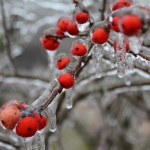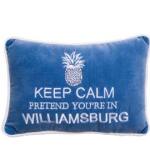 Colonial Williamsburg is known for its boxwoods. Both the American boxwood (Buxus sempervirens) and the English boxwood (Buxus sempervirens ‘suffruticosa’) provide structure to our gardens and substance to our Christmas decorations.
Colonial Williamsburg is known for its boxwoods. Both the American boxwood (Buxus sempervirens) and the English boxwood (Buxus sempervirens ‘suffruticosa’) provide structure to our gardens and substance to our Christmas decorations.
Not as common, but just as historic, is a variegated form (Buxus sempervirens ‘elegantisima’) which can be found growing in the Colonial Garden and Nursery on Duke of Gloucester Street.
Prominent colonist John Custis grew variegated boxwood in his Williamsburg garden. Apparently Custis, like many of us today, grew what he liked regardless of current trends. In 1736, he wrote, “I am told those things (striped boxwood and variegated plants) are out of fashion; but I do not mind that I always make my fancy my fashion.”
Native to North Africa, western Asia and Europe, boxwood was introduced to North America in the mid-1600s. The wood, close-grained and of bonelike hardness, was used by the colonists for making musical instruments and decorative items. The inlay work on the staircase in the reconstructed Governor’s Palace is of boxwood and holly.
In June, one of the primary tasks for our gardeners is to shear the boxwood. Shearing is done annually to maintain the size and shape of the boxwood. Topiary work (pruning plants into various contrived shapes) is completed by mid-summer so that the new growth can harden-off before frost.
In addition to boxwood, yaupon holly (Ilex vomitoria) is the other predominant plant used for topiary. Native to southeastern North America, yaupon holly is drought-tolerant and adaptable to a variety of soils.
Dr. Alexander Garden of Charleston found that “it makes a very good and most beautiful hedge and may be kept as short and neat as Box.” However, unlike the slow-growing boxwood that only needs to be sheared once a season, the fast-growing yaupon needs to be sheared at least three times a season.
Who was John Custis?
Born in 1678 on the Eastern Shore of Virginia, John Custis was a planter, a member of the House of Burgesses and served as member of the Governor’s Council in Williamsburg. He was William Byrd II’s brother-in-law, and the father of Martha Washington’s first husband, Daniel Parke Custis. Custis’ garden in Williamsburg became one of the finest gardens of its day in all the colonies.
The Philadelphia botanist, John Bartram, judged Custis’ garden as second only to John Clayton’s Gloucester County garden. Custis exchanged plants and corresponded with English botanist Peter Collinson from 1734 to 1746. Their letters survived and have been published in a book entitled Brothers of the Spade. Their twelve-year correspondence adds to our knowledge of plants and gardening in 18th-century Williamsburg.


Leave a Reply